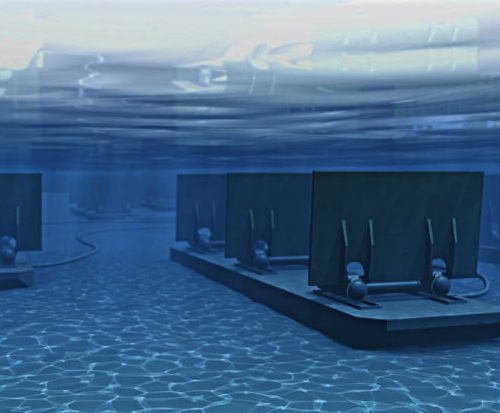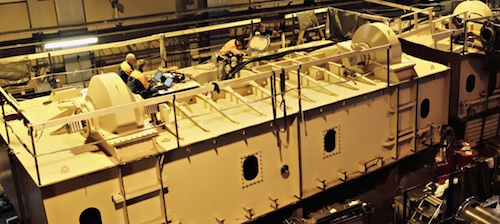
WaveRoller Arrives in Portugal for Long Awaited Tests
The WaveRoller arrived on January 2nd at Portugal’s Peniche Shipyard for a much anticipated pilot test this summer off the coast of Portugal, one of the best testing sites in Europe for ocean energy. The scaled-up version for the pilot test is to be tested in the same waters near the sea shore of Peniche where its smaller prototype showed promise (Previous: WaveRoller Uses Swinging Door for Underwater Wave Energy.)
Wave energy involves very large machines that must survive harsh underwater conditions. Even this pre-commercial version weighs 280 tons, and the test has been financed by the European Commission.
The Waveroller is anchored on the sea bottom at a depth of 10-25 meters and unlike the majority of the ideas being pursued in wave energy, using surface waves, it takes advantage of the back-and-forth movement of the surge pushing back and forth close to the sea floor.
The invention was inspired by a complete accident, when the Finnish diver Rauno Koivusaari almost got hit on the head by a powerfully flapping door on a shipwreck 15 years ago, and had a Eureka moment, and began working on the idea.
I met the new CEO, John Liljelund in Finland on a green blogger’s tour, and he was thrilled at the prospect of this pilot test, but told me that testing is so prohibitively expensive in wave energy, that it really has slowed the pace of this last frontier of renewable energy innovation.

For example, each of the three “doors” of the units weighs twenty tons, and of course it has to be constructed to withstand typical underwater wear and tear, yet as a pilot project – it is a “one-off” – with none of the cost amortization that mass production brings.
Liljelund told me in 2010 that it was to be tested in Portugal in 2011. But I was disappointed to hear last summer that it was not the Portugal test he had predicted, but an indoor test in machine room blocks, albeit at the full pilot test size, and in simulated conditions at EMEC in Scotland. Money is hard to come by until a new technology is commercially deployable.
But that bench test in Scotland resulted in output far higher than had been expected in tests over a six-week period in several different wave states, each corresponding to real-life conditions. As a result of those better than expected results, several European utility companies, including previous collaborators and new potential partners are considering commercial applications.
Finally, at real scale, all 280 tons of WaveRoller has drawn into port for pilot testing in deep sea conditions this summer in Portugal. Stay tuned.
Source: Clean Technica

